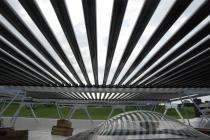Natural Fusion: Solar-powered home designed for 'realities of life'

(PhysOrg.com) -- Long cylinders wrapped in a thin dark blue film rest atop a newly constructed home in Central Pennsylvania. Beneath the cylinders is vegetation. The arrangement is not only the engine that powers the house, but may be evidence that the future of solar-powered homes has arrived.
Penn State's Solar Decathlon team, which will compete Oct. 9-18 on the National Mall in Washington, D.C. next month, installed these photovoltaic solar panels on Natural Fusion, the 800-square- foot house the team is constructing for the Department of Energy-sponsored competition among colleges and universities to create the best solar-powered home.
The local community can tour the home from noon-6 p.m. on Friday (Sept. 25) at its current location at the southwest end of Innovation Boulevard in Innovation Park. In conjunction with the day of tours, actor and environmentalist Ed Begley, Jr. will speak at 8 p.m. in Dean's Hall of the Penn Stater Conference Center Hotel. Begley's lecture and the tours are free and open to the public. At the tours, the Penn State community will get a first look at some unique and innovative applications.
Natural Fusion is the first residential project to utilize the Solyndra cylindrical photovoltaics, which captures more sunlight throughout the entire day than traditional flat panels, which can only capture the most intense sunlight in the middle of the day. It's a system called Green Roof Integrated Photovoltaics (GRIP V) where the properties of the green roof beneath the panels create greater efficiency in powering the house.
"What we've done, by using a green roof under our panels, rather than what would typically be a white roof application, we found the reflectivity is a little less efficient. But that minimal difference is made up, and actually more so, by the cooling effect the plants have being underneath," explained Thomas Rauch, Natural Fusion team member and media liaison. "Any electrical system runs more efficiently at colder temperatures. It's really a neat way of integrating multiple systems and increasing the overall efficiency."
The integration of systems not only allows the home to operate at high efficiency, it is also an example of the philosophy behind Natural Fusion to integrate nature and human construction, aesthetics and function, all while using innovative sustainable technology. From the team's construction through the life of the home, Natural Fusion is expected to produce zero emissions. That means the team used solar power to work on the home and evaluated energy consumption used to make the products included in the home.
The team has worked with industry sponsors to install unique and functional technology throughout the home. Sunnovations, which produces solar hot water systems, supplied Natural Fusion with a system that collects heat from the sun and distributes it through the house without using controls or pumps, making it maintenance free.
"The concept is mind-boggling." Rauch said. "It uses physics to do the job."
Along with larger technological innovations, the house also employs various integrated architectural features that make it special.
Wood siding from an old Pennsylvania barn was reclaimed and sealed to use as the home's flooring.
"It adds a lot character to the home and has a story," Rauch said. "It's those little things that take us from being a catalog to being a home that's unique and something to get excited about."
The wall separating the kitchen and bathroom, meanwhile, is what the team calls the "Life Well," an indoor garden with herbs and other plants that can simply be plucked from the wall to use in cooking.
"We haven't just designed a home. We've put a lot of thought into how we can make it intrinsic for people to live in a sustainable way," Rauch said. "We've designed with the end-user, with greater science and with simplicity in mind. The outcome is a house which is wonderfully simple, with the idea that technology doesn't have to be complicated to work well. We've engineered for the reality of life. We believe we are introducing practices and possibilities that can be implemented in the industry and make a change immediately."
After spending well over a year designing and building the home Penn State team will move the home to the Solar Village in Washington for the competition in October, where it will then compete in a series of 10 events to determine the best solar powered home.
More information:
For more information on Natural Fusion, visit naturalfusion.org.
For more on the Solar Decathlon, visit solardecathlon.org.
Provided by Pennsylvania State University (news : web)



















